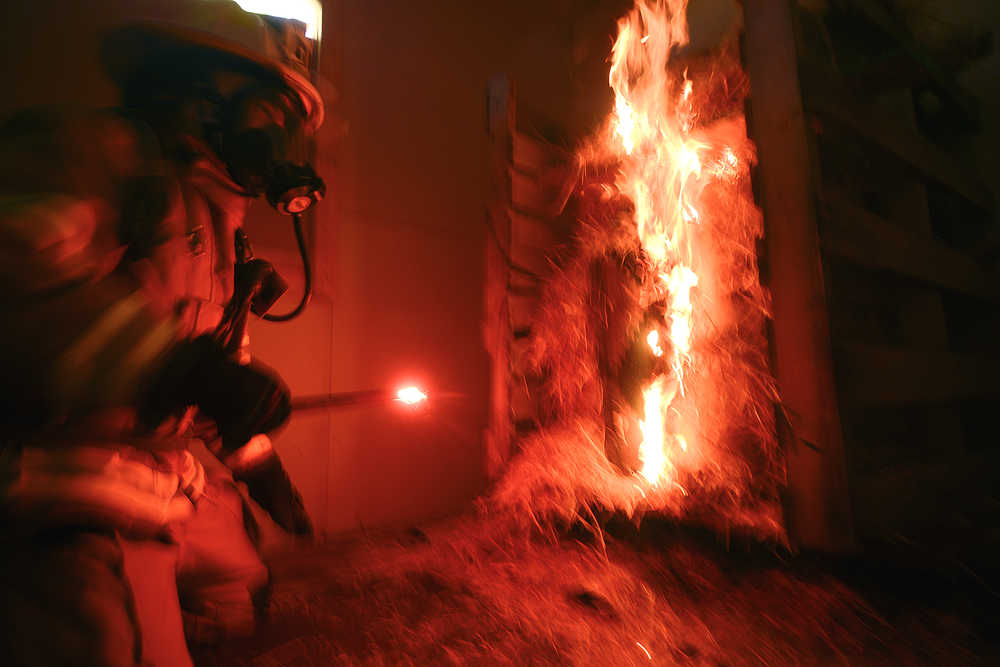In a gravel lot on Arc Loop road, four men with nearly a century of firefighting experience among them, stood hunched over in the noon sun, struggling to breathe.
Each had climbed out of a burning building where teams of Central Emergency Services and ConocoPhillips firefighters took turns running inside and searching for bodies during a training drill.
It wasn’t the flames, but the heat that finally got to the four men.
They were among the first to use the newest CES training facility — the first to light it on fire, the first marked by ash and soot that left long, black lines on walls and the first to learn that the new building holds smoke and heat well.
A little too well, said Kenai Peninsula Borough Health and Safety Officer Brad Nelson as he stood with the group of trainers who’d left the building after the drill. Each bent at the waist toward the ground, inhaling deeply, attempting to breathe and recover from the first drill of the day.
“We (built) it a little tighter than we thought,” Nelson said as sweat dripped steadily down his face. “It’s good because a lot of Alaskans build really tight, so this is a realistic situation our guys would get into.”
Nelson and other CES administrators teamed up with two other trainers from New York State fire departments to run several drills for 21 firefighters Wednesday and, in the process, test out the newest CES facility.
“The heat is what fatigues guys,” said CES firefighter Josh Thompson.
The heat is also what makes the new facility and training drills more effective, he said. When the firefighters do drills without fire, it’s easy to overestimate their strength and abilities.
“You find yourself going a lot longer than you normally would,” he said
As the searching drill went on, teams of three firefighters pulled their oxygen masks on and pushed through the smoky doorway. They dropped to their knees and crawled into the bedrooms, up a set of stairs and down smoke-filled hallways, searching for victims.
Thompson said he was learning ways to search a burning structure that didn’t require keeping the team of firefighters together.
“Instead of the old school way where you’re all together, we’re breaking off and searching one man to a room,” he said. “Send three guys into an 8-by-10 bedroom and you end up bumping into each other more than anything.”
While some learned new techniques, trainer Bob Pressler said the training was also about learning one-way to do things well — rather than trying several different ways.
“The idea is to learn one efficient way and then the shortcuts will come after that,” Pressler said.
After the simulation was finished, most of the firefighters went back into the building to fully extinguish the blaze, remove burned sheetrock and reset the facility for the next drill.
The building is designed for repeated use. The sheetrock and wood will need to be replaced periodically, but the metal frame should withstand repeated fires, Nelson said.
Pressler paused occasionally to direct the trainees toward the next area to be cleaned.
He gathered the group together after the drill was over to talk about things that worked and things that didn’t.
One crew had searched the same area as a previous crew, he said.
Another had gone into a room where the heat and smoke where so intense — the likelihood of finding a survivor was slim.
Firefighters have to know their limits, even when at the doorway of a room where a fire victim could be hidden from view.
“The whole history of (firefighters) who’ve gotten themselves in trouble is that they just wanted to go, to look a little bit further,” he said.
He and the other visiting trainer, Mike Lombardo, spent a lot of time talking about shortcuts and ways to get in and out of a burning building both safely and quickly.
“It’s not that they’re not doing it right, they’re doing it the way that they’ve been show up here,” he said of the Kenai Peninsula firefighters. “Coming out of (New York) we’ve been to a couple more fires than them, we’ve found efficient ways to do things.”
Pressler said fire departments in Alaska use the same firefighting techniques once they arrive at a fire as those in the Lower 48, but there are unique challenges.
“The thing that hurts them here is time and distance,” he said. “A lot of times, by the time they get there, there’s not a lot they can do. What we look for is effective ways of them doing things. They’ve been doing their jobs this way for years, and it’s not like the fires didn’t go out, but maybe we can cut a minute-and-a-half off an operation.”
For CES firefighter Matt Seizys, Wednesday’s training was the second he’s done during his 9-months as a firefighter.
Seizys said having a burning building to practice in helped him retain the lessons.
“It’s adding actual stress to the situation, because normally when we do the training, we have no stress,” he said. “It teaches you to be more aware of your surroundings ‘cause you have actual smoke and fire. It’s not simulated, it’s real.”
Reach Rashah McChesney at rashah.mcchesney@peninsulaclarion.com

